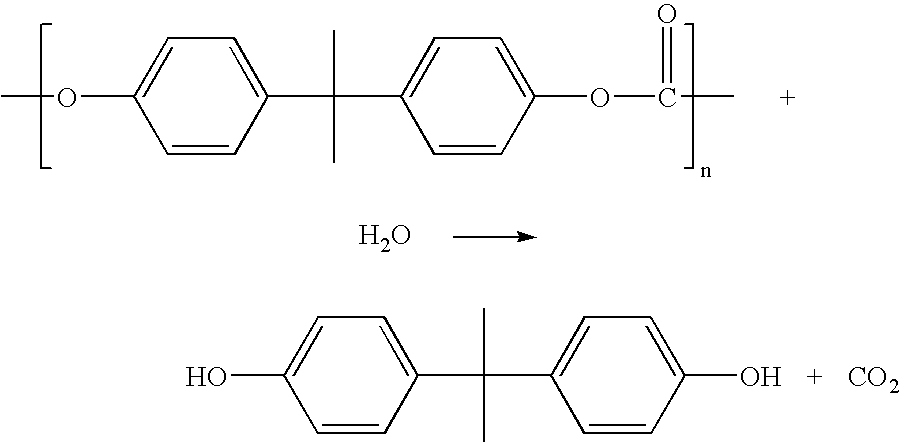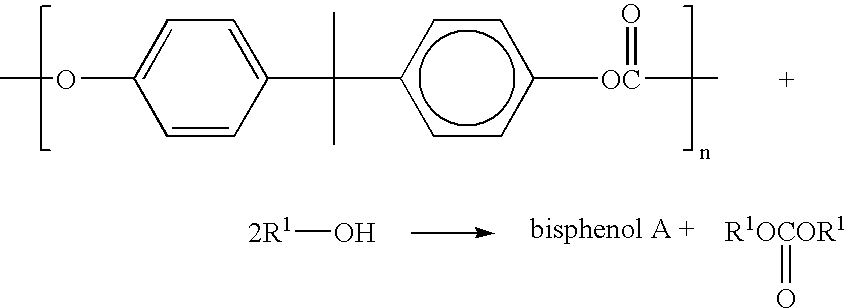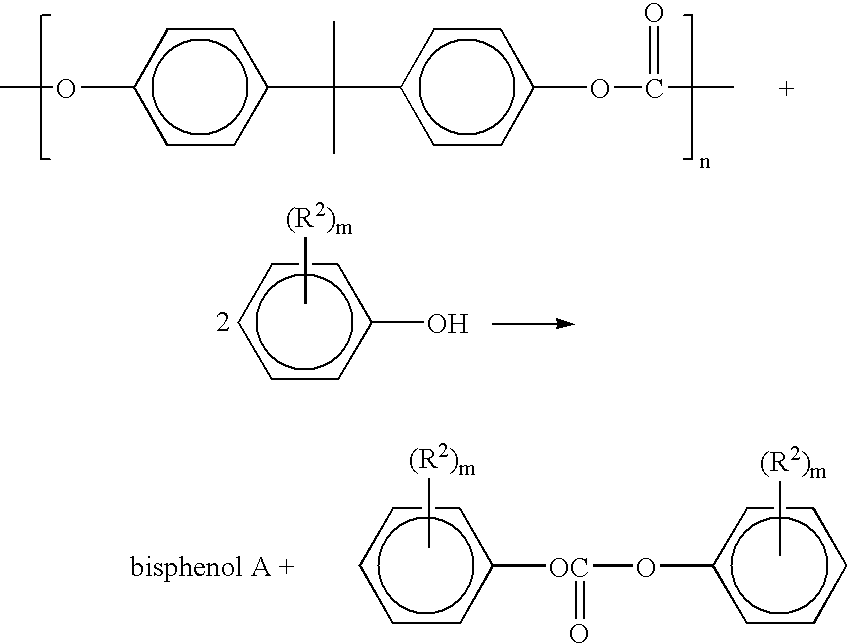Method for depolymerizing aromatic polycarbonate
a technology of aromatic polycarbonate and polycarbonate, which is applied in the field of depolymerizing aromatic polycarbonate, can solve the problems of not only waste of resources but also global-scale social problems, and the inability to find an effective method, and achieves the effects of reducing the number of oxidized compounds, and improving the quality of aromatic polycarbona
- Summary
- Abstract
- Description
- Claims
- Application Information
AI Technical Summary
Benefits of technology
Problems solved by technology
Method used
Image
Examples
example 1
[0095] 5.0 g of polycarbonate resin pellets (AD-5503 of Teijin Chemicals, Ltd., average molecular weight of 15,000) and 10 ml of water were fed to an autoclave having a total capacity of 113 ml, 15 g of solid carbon dioxide (dry ice) was fed to the autoclave, and the autoclave was sealed up and heated under agitation with a magnetic stirrer. After the temperature reached 250.degree. C., that temperature was maintained for 4 hours. The pressure was 228 atm. After the reaction, the autoclave was cooled to room temperature quickly, carbon dioxide was discharged, and the contents of the autoclave were taken out. When the contents were analyzed by gas chromatography, 3.49 g of bisphenol A was obtained (yield of 78%). The product was all soluble in methanol and the raw material polymer was almost inexistent.
example 2
[0096] Like Example 1, 5.0 g of polycarbonate resin pellets, 10 ml of water and 25 g of carbon dioxide were fed to an autoclave having a total capacity of 113 ml, stirred while the autoclave was sealed up, heated at 230.degree. C. and maintained at that temperature for 4 hours. The pressure was 202 atm. After the reaction, the autoclave was cooled to discharge carbon dioxide and the contents were taken out and divided into a methanol-soluble portion and methanol-insoluble portion. When the methanol-soluble portion was analyzed by gas chromatography, 0.77 g of bisphenol A was obtained (yield of 16.5%). The methanol-insoluble portion was dried and when 4.02 g of the portion was used for the measurement of viscosity in E sol, the viscosity .eta.sp / c was 0.171. (.eta.sp / c of the original polycarbonate was 0.47 which was reduced by depolymerization.)
example 3
[0098] (Reaction in Critical Methanol)
[0099] The method carried out in Example 3 is shown in the process diagram of the attached FIG. 1. 5.0 g of polycarbonate resin 2 (ground product of a compact disk) was fed to a 113 ml autoclave A and heated at 245.degree. C. under agitation with a magnetic stirrer. When the temperature reached 245.degree. C., preheated methanol was continuously added to the autoclave at a rate of 2.5 ml / min to carry out a reaction. After 30 minutes, the introduction of methanol was stopped to complete the reaction. The pressure at this point was 8.3 MPa. The reaction product was then transferred to a pressure distillation column B and subjected to distillation at 150.degree. C. and 1.5 MPa, an azeotropic mixture obtained from the top of the column was returned to the autoclave A together with methanol, dimethyl carbonate 3 was taken out from the middle portion of the column, and bisphenol A4 was taken out from the bottom of the column. When the quenched content...
PUM
| Property | Measurement | Unit |
|---|---|---|
| temperature | aaaaa | aaaaa |
| temperature | aaaaa | aaaaa |
| weight ratio | aaaaa | aaaaa |
Abstract
Description
Claims
Application Information
 Login to View More
Login to View More - R&D
- Intellectual Property
- Life Sciences
- Materials
- Tech Scout
- Unparalleled Data Quality
- Higher Quality Content
- 60% Fewer Hallucinations
Browse by: Latest US Patents, China's latest patents, Technical Efficacy Thesaurus, Application Domain, Technology Topic, Popular Technical Reports.
© 2025 PatSnap. All rights reserved.Legal|Privacy policy|Modern Slavery Act Transparency Statement|Sitemap|About US| Contact US: help@patsnap.com



